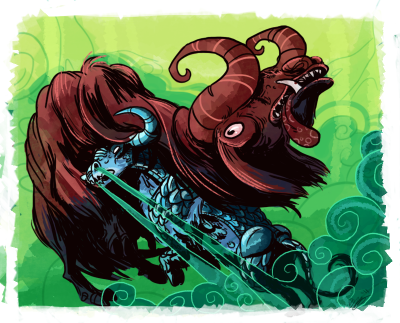 |
| Catoblepas ©1998 Jonathan Hunt |
In medieval bestiaries the catoblepas (plural catoblepones, meaning “downward-looking”) is generally depicted as a distorted wildebeest (seen in the previous image) and attributed with a deadly gaze and poisonous breath due to its diet of poisonous plants. Fortunately, its head is so heavy it always looks downward and never kills with its gaze.
The catoblepas and Topsell’s gorgon are believed to be distorted accounts of wildebeests, so the names “catoblepas” and “gorgon” were used the Linnaean taxonomy of some wildebeest species.
The catoblepas appears in Flaubert’s The Temptation of Saint Anthony, where it is described with a grotesquely long neck. This description appears to be what inspired its typical depiction in fantasy gaming.
 |
| Catoblepas ©1999 Todd Lockwood |
When the catoblepas was translated to fantasy gaming, it underwent slight modifications. The catoblepas in bestiaries was too similar to the gorgon, so it was given the long neck of its Temptation appearance as well as a long, clubbed tail like an ankylosaur (seen in the previous image). Like its source, its gaze caused spontaneous death.
Variants of the catoblepas would appear in other books. I would refer to the Catoblepas article at ENWorld for a more detailed account. Of note are the depictions from "The Ecology of the Catoblepas (or, looks can be very deceiving)" article in Dragon #73 and the 4th edition. Dragon claims that the male catoblepas is a kangaroo-like creature, although this was never mentioned again in later books. 4th edition changed the catoblepas to a fey creature with a humanoid face that portended misfortune, although this too was forgotten completely in later editions.
With the advent of the OGL, a couple of other catoblepas variants would appear in third party books. Forgotten Foes depicted the traditional ankylosaur variety, except here its deadly gaze was tweaked so that it had multiple possible results depending on which body parts were hit rather than a simple “save or die” effect. Pathfinder Bestiary depicted it as the wildebeest-like creature of medieval bestiaries. Other supplements and articles generally depicted variations of these two recognizable concepts.
 |
| Catoblepas concepts, Final Fantasy XV |
In the Final Fantasy series of video games, the catoblepas appears as a recurring enemy. Different games portray it in dramatically different fashions. Sometimes it is merely a variant of another monster, sometimes it is a unique monster. Different appearances are depicted with various features such as a long neck, bull horns, wings, or a single cyclopean eye. One concept artwork (seen in the previous image) depicted it as having a gorilla-like posture and the drooping head of folklore, but this version never appeared in the games proper.
There is really no reason that I can see why these varieties cannot coexist in the same setting. If you need to distinguish them by name, the long-necked club-tailed catoblepas could be named “catoblepas ankylodocus,” the tusked armored wildebeest “catoblepas gnu,” and the fey catoblepas “fey catoblepas” (lol). In one so desired, the Topsell-derived gorgon might be made a cousin species named “catoblepas gorgon.”
 |
| Catoblepas vs Gorgon, by Blanca Martinez |
Research links
- http://bestiary.ca/beasts/beast2821.htm
- http://bestinslot.wikia.com/wiki/Ankylodocus
- http://blogicaster.blogspot.com/2009/11/capering-catoblepas.html
- http://dailybestiary.blogspot.com/2011/09/catoblepas.html
- http://finalfantasy.wikia.com/wiki/Catoblepas_(enemy)
- http://forgottenrealms.wikia.com/wiki/Catoblepas
- http://monsternomicon.tumblr.com/post/58769913739
- http://stevesgamerblog.blogspot.com/2010/06/steves-monster-manual-3-designs_16.html
- http://themonstersknow.com/catoblepas-tactics/
- http://wierdnwildcreatures.wikia.com/wiki/Catoblepas
- http://www.dungeonsanddrawings.com/2011/02/catoblepas-and-gorgon.html
- https://www.enworld.org/threads/monster-encyclopedia-catoblepas.662425/
- http://www.generaltheoryofcreativity.com/illustration/catoblepas.html
- http://www.theoi.com/Thaumasios/Katoblepones.html
- https://1d4chan.org/wiki/Catoblepas
- https://abookofcreatures.com/2015/08/03/catoblepas/
- https://d-infinity.net/game-content/catoblepas-dd-5e-monster
- https://imaginarybeingsmuseum.wordpress.com/2015/05/17/catoblepas/
- https://m0ai.deviantart.com/art/Catoblepas-216722521
- https://runkleplaysgames.com/2014/03/11/catoblepas/
- https://web.archive.org/web/20081211062337/http://www.eaudrey.com:80/myth/catoblepas.htm
- https://www.d20pfsrd.com/bestiary/monster-listings/magical-beasts/catoblepas-ff/
- https://www.d20pfsrd.com/bestiary/monster-listings/magical-beasts/catoblepas/
- https://www.sarahsawyer.com/2010/11/mythic-creatures-the-catoblepas/
- http://alphabeastiary.blogspot.com/search/label/creature%3A%20Catoblepas
- https://www.deviantart.com/popular-all-time/?section=&global=1&q=alphabeastiary+catoblepas
No comments:
Post a Comment